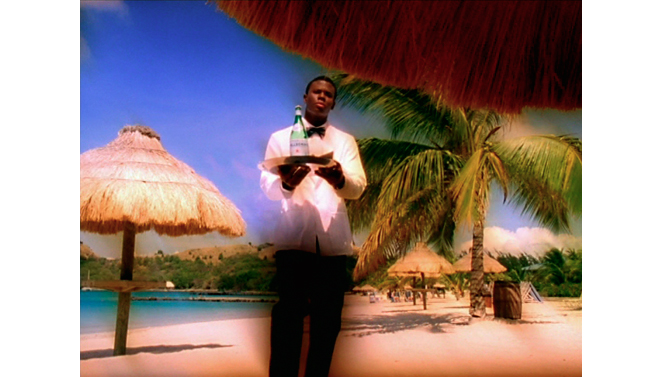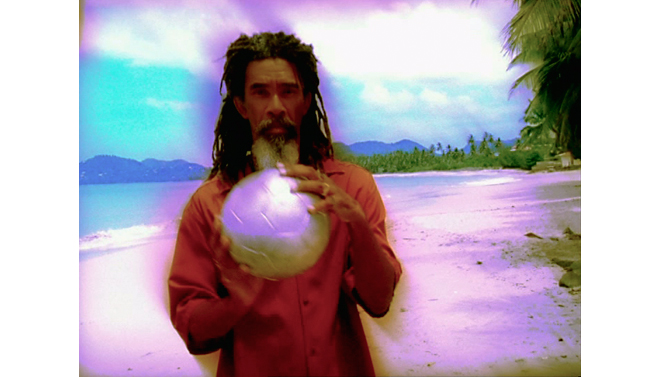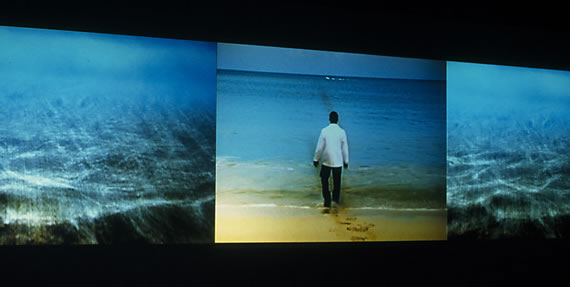
Isaac Julien is in group show:
THE NEW HUMAN
You and I in Global Wonderland
With Paradise Omeros (2002)
Malmö 14 March 2015 – 18 October 2015 in Museet Malmö.
Robertha Smith NYTimes about Paradise Omeros:
Isaac Julien — ‘Paradise Omeros’, July 11, 2003
Few artists have cut as impressive a swath between structural and narrative film as the British artist Isaac Julien. His film installations effortlessly alternate between the specific and elliptical, the documentary and disorienting visual effects, creating a dazzling crisscrossing path that seems appropriate to the theme of doubled otherness — the plight of the black homosexual immigrant in the West — that is central to his work.
”Paradise Omeros,” commissioned by the Bohen Foundation and seen at Documenta 11 in Kassell, Germany, last year, is no exception, but it is among the most naturalistic and subtle and least baroque of Mr. Julien’s films. It takes its title from Derek Walcott’s epic poem ”Omeros” (the title comes from the Greek name for Homer), centering on excerpts that recast the wanderings of a hero as the often mournful lament of a Caribbean immigrant in London.
Completing a trans-Atlantic Triangle that began with the slave trade, he encounters racial prejudice and the changing seasons for the first time. It is, as a voice-over by Mr. Walcott says, as if we were in England to pay for our sins.

Projected on a triptych of large screens, the 24-minute film alternates between the paradise of St. Lucia and the concrete jungle of London’s projects, between a cabin nestled in the natural jungle where unspecified violence sets a young man running through the undergrowth and an immigrant family’s London apartment.

There’s a party under way; interracial couples dance to Caribbean music while a dreamlike scene of a father beating his grown son flashes in the background. The son is Achilles, the film’s handsome hero, played with intelligence and grace by Hansil Jules, a young actor-singer born on St. Lucia. He begins the film as a waiter at an island resort and ends it in London on the verge of a sexual encounter with an equally godlike white youth who seems, at first, to be stalking him.
As is usual with Mr. Julien’s work, this story takes place against a background that encompasses the more general yet intricate workings of race, class, culture, desire and memory that bring people together or set them apart. At the same time it mixes in references to literature, movies, performance art and painting, while playing aggressively with the complex, often abstracting visual potential of film.
For example, the party scene includes a sharp portrait of Achilles’ sexually predatory, hard-drinking father and his sweet but dominating mother. (Watch the way she hands Dad a guest’s wrap.) But the sequence begins with some purely cinematic drama, a tracking survey of the apartment’s contents that conveys a vivid sociological picture while also making it appear that the furniture is moving, almost dancing. Similarly, Mr. Julien also exploits the physiological effects of the ocean’s buffeting waves and currents, especially in an inverted image of Achilles’ drifting underwater that serves as a beautiful metaphor for his anxiety.

Perhaps most dramatic is a close-up of a closing elevator door that travels across three big screens, effectively erasing the monumental image of Achilles’ face with a startling metallic finality, conjuring up both a prison and the silver screen.
The most complicated part of Mr. Julien’s crisscrossing path may lie in his ability to balance a clear-eyed evocation of the tragic effects of history with his faith in the power of individual will and creativity, and above all, love. This is bluntly yet hopefully signaled by two very different shamanlike characters who tell Achilles of the eternal battle between love and hate, which love always wins.
They do so while wearing rings spelling love and hate, echoing both Robert Mitchum’s famous scene in ”Night of the Hunter” and its reprise in Spike Lee’s ”Do the Right Thing.” ROBERTA SMITH
Photos: At the Bohen Foundation, installation views of Isaac Julien’s ”Paradise Omeros,” which tells the story of a young man who moves to London from St. Lucia and suffers the plight of a black homosexual immigrant.
About The New Human exhibition:
THE NEW HUMAN is a video-based exhibition project that artistically explores our current condition as humans, while also presenting imagined scenarios of our future. The project’s first chapter, titled You and I in Global Wonderland, will take over the entire upper level of Moderna Museet Malmö starting on March 14. It addresses pressing issues of our time relating to migration, alienation, and political and religious extremism, including the rise of nationalist and neo-fascist movements in Sweden and Europe.
Art has the ability to shed new light on reality as we confront it on the street and on the screen, and to raise questions about the norms and values of our time. The chapter You and I in Global Wonderland explores some of our hopes and dreams, but also feelings of fear and frustration about how we should and could live together in a changing world. Eleven internationally active and acclaimed artists are contributing to the exhibition: Yael Bartana, Robert Boyd, Loulou Cherinet, Ioana Cojocariu, Cao Fei, Esra Ersen, Isaac Julien, Santiago Mostyn, Adrian Paci, Tomáš Rafa, and Ferhat Özgür.
We get to share experiences of gigantic transformation and human migration brought on by war, climate change, and economic globalization. There are works exploring the widespread extremism of our time, and others that remind us of the colonial past and how it continues to affect the way we live together as humans today. As an exhibition, You and I in Global Wonderland may convey a longing for something lost—perhaps an earlier life ruined by war—but it will also present us with feelings of tenderness, disorientation, and comedy arising from the confrontation between different cultures, languages, and lifestyles.
All works presented in THE NEW HUMAN have been produced since the year 2000, the turn of the millennium, and span from seminal contemporary classics to very recent productions. At Moderna Museet Malmö, THE NEW HUMAN will be presented in two extensive chapters, each with a different focus and subtitle: You and I in Global Wonderland in 2015 and Knock, Knock, Is Anyone Home? in 2016. A third chapter will thereafter be presented at Moderna Museet in Stockholm in the fall of 2016.
THE NEW HUMAN is the result of a substantial collaboration between Julia Stoschek Collection in Düsseldorf and Moderna Museet Malmö, and it includes work from both these collections as well as loans from individual artists.
Curator: Joa Ljungberg.

